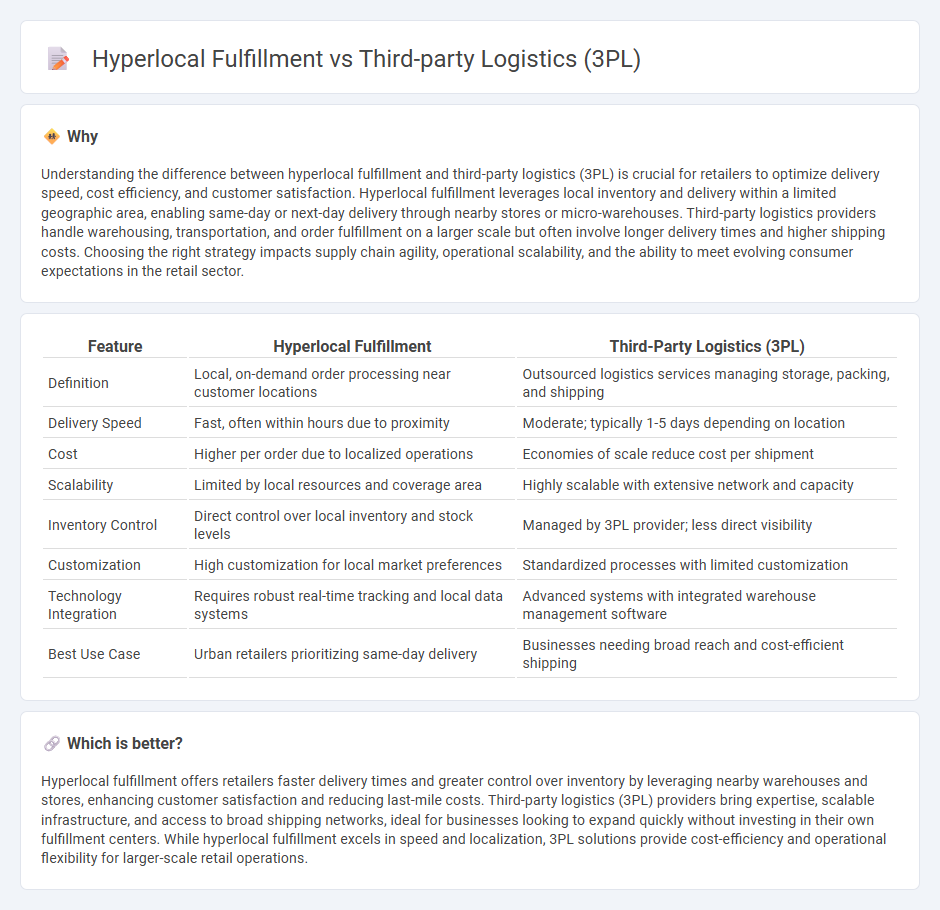
Hyperlocal fulfillment leverages proximity-based inventory management to expedite deliveries within a specific geographic area, enhancing customer satisfaction through faster service. In contrast, third-party logistics (3PL) providers manage broader supply chain operations including warehousing, transportation, and distribution, often at a national or global scale, optimizing cost-efficiency and scalability. Discover how choosing between hyperlocal fulfillment and 3PL can transform your retail strategy.
Why it is important
Understanding the difference between hyperlocal fulfillment and third-party logistics (3PL) is crucial for retailers to optimize delivery speed, cost efficiency, and customer satisfaction. Hyperlocal fulfillment leverages local inventory and delivery within a limited geographic area, enabling same-day or next-day delivery through nearby stores or micro-warehouses. Third-party logistics providers handle warehousing, transportation, and order fulfillment on a larger scale but often involve longer delivery times and higher shipping costs. Choosing the right strategy impacts supply chain agility, operational scalability, and the ability to meet evolving consumer expectations in the retail sector.
Comparison Table
| Feature | Hyperlocal Fulfillment | Third-Party Logistics (3PL) |
|---|---|---|
| Definition | Local, on-demand order processing near customer locations | Outsourced logistics services managing storage, packing, and shipping |
| Delivery Speed | Fast, often within hours due to proximity | Moderate; typically 1-5 days depending on location |
| Cost | Higher per order due to localized operations | Economies of scale reduce cost per shipment |
| Scalability | Limited by local resources and coverage area | Highly scalable with extensive network and capacity |
| Inventory Control | Direct control over local inventory and stock levels | Managed by 3PL provider; less direct visibility |
| Customization | High customization for local market preferences | Standardized processes with limited customization |
| Technology Integration | Requires robust real-time tracking and local data systems | Advanced systems with integrated warehouse management software |
| Best Use Case | Urban retailers prioritizing same-day delivery | Businesses needing broad reach and cost-efficient shipping |
Which is better?
Hyperlocal fulfillment offers retailers faster delivery times and greater control over inventory by leveraging nearby warehouses and stores, enhancing customer satisfaction and reducing last-mile costs. Third-party logistics (3PL) providers bring expertise, scalable infrastructure, and access to broad shipping networks, ideal for businesses looking to expand quickly without investing in their own fulfillment centers. While hyperlocal fulfillment excels in speed and localization, 3PL solutions provide cost-efficiency and operational flexibility for larger-scale retail operations.
Connection
Hyperlocal fulfillment leverages third-party logistics (3PL) providers to optimize last-mile delivery by using local warehouses and distribution centers, ensuring faster and more efficient order processing. 3PL services offer retailers scalable infrastructure and advanced technology integration, enabling precise inventory management and real-time tracking in hyperlocal markets. This collaboration enhances customer satisfaction through reduced delivery times and increased order accuracy, driving competitive advantage in retail fulfillment.
Key Terms
Outsourcing
Third-party logistics (3PL) providers offer comprehensive outsourcing solutions for warehousing, transportation, and inventory management, enabling businesses to scale efficiently across regions. Hyperlocal fulfillment focuses on rapid, proximity-based delivery within specific neighborhoods or cities, prioritizing speed and customer convenience through local distribution centers or retail partnerships. Explore the benefits and strategic considerations of outsourcing in 3PL versus hyperlocal fulfillment to optimize your supply chain performance.
Last-mile delivery
Third-party logistics (3PL) providers offer comprehensive supply chain solutions, including warehousing, transportation, and last-mile delivery, catering to broad geographic areas and diverse customer bases. Hyperlocal fulfillment specializes in rapid last-mile delivery within a limited radius, leveraging nearby inventory and real-time data to meet urgent, same-day or next-day delivery demands. Explore how combining 3PL scale with hyperlocal speed can optimize your last-mile delivery strategy.
Inventory proximity
Third-party logistics (3PL) providers manage inventory across centralized warehouses, often optimizing large-scale distribution but potentially increasing last-mile delivery times. Hyperlocal fulfillment prioritizes inventory proximity by storing products within or near urban areas, reducing delivery time and improving customer experience through rapid order fulfillment. Explore how inventory strategies impact efficiency and service quality in both models.
Source and External Links
What is 3PL (third-party logistics)? - A 3PL provider offers outsourced logistics services that manage one or more facets of procurement and fulfillment, such as warehousing and shipping, allowing businesses to control costs and focus on core competencies.
What is a 3PL? Third-Party Logistics Process Explained - Third-party logistics (3PL) companies help businesses optimize supply chains by providing services like inventory management, order fulfillment, and transportation, enabling companies to streamline operations and focus on growth.
What Is a 3PL? The Beginner's Guide to Third-Party Logistics - A 3PL is a service provider that handles or arranges various supply chain functions such as shipping, storing, and packaging, helping businesses outsource logistics for efficiency, expertise, and cost savings.
 dowidth.com
dowidth.com